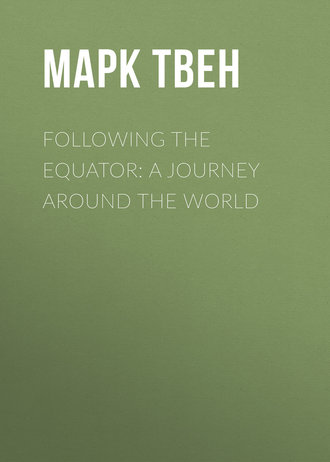 полная версия
полная версияFollowing the Equator: A Journey Around the World
“You can call it anything you want to, and be right. It is a fish, for it lives in the river half the time; it is a land animal, for it resides on the land half the time; it is an amphibian, since it likes both and does not know which it prefers; it is a hybernian, for when times are dull and nothing much going on it buries itself under the mud at the bottom of a puddle and hybernates there a couple of weeks at a time; it is a kind of duck, for it has a duck-bill and four webbed paddles; it is a fish and quadruped together, for in the water it swims with the paddles and on shore it paws itself across country with them; it is a kind of seal, for it has a seal’s fur; it is carnivorous, herbivorous, insectivorous, and vermifuginous, for it eats fish and grass and butterflies, and in the season digs worms out of the mud and devours them; it is clearly a bird, for it lays eggs, and hatches them; it is clearly a mammal, for it nurses its young; and it is manifestly a kind of Christian, for it keeps the Sabbath when there is anybody around, and when there isn’t, doesn’t. It has all the tastes there are except refined ones, it has all the habits there are except good ones.
“It is a survival – a survival of the fittest. Mr. Darwin invented the theory that goes by that name, but the Ornithorhynchus was the first to put it to actual experiment and prove that it could be done. Hence it should have as much of the credit as Mr. Darwin. It was never in the Ark; you will find no mention of it there; it nobly stayed out and worked the theory. Of all creatures in the world it was the only one properly equipped for the test. The Ark was thirteen months afloat, and all the globe submerged; no land visible above the flood, no vegetation, no food for a mammal to eat, nor water for a mammal to drink; for all mammal food was destroyed, and when the pure floods from heaven and the salt oceans of the earth mingled their waters and rose above the mountain tops, the result was a drink which no bird or beast of ordinary construction could use and live. But this combination was nuts for the Ornithorhynchus, if I may use a term like that without offense. Its river home had always been salted by the flood-tides of the sea. On the face of the Noachian deluge innumerable forest trees were floating. Upon these the Ornithorhynchus voyaged in peace; voyaged from clime to clime, from hemisphere to hemisphere, in contentment and comfort, in virile interest in the constant change of scene, in humble thankfulness for its privileges, in ever-increasing enthusiasm in the development of the great theory upon whose validity it had staked its life, its fortunes, and its sacred honor, if I may use such expressions without impropriety in connection with an episode of this nature.
“It lived the tranquil and luxurious life of a creature of independent means. Of things actually necessary to its existence and its happiness not a detail was wanting. When it wished to walk, it scrambled along the tree-trunk; it mused in the shade of the leaves by day, it slept in their shelter by night; when it wanted the refreshment of a swim, it had it; it ate leaves when it wanted a vegetable diet, it dug under the bark for worms and grubs; when it wanted fish it caught them, when it wanted eggs it laid them. If the grubs gave out in one tree it swam to another; and as for fish, the very opulence of the supply was an embarrassment. And finally, when it was thirsty it smacked its chops in gratitude over a blend that would have slain a crocodile.
“When at last, after thirteen months of travel and research in all the Zones it went aground on a mountain-summit, it strode ashore, saying in its heart, ‘Let them that come after me invent theories and dream dreams about the Survival of the Fittest if they like, but I am the first that has done it!
“This wonderful creature dates back like the kangaroo and many other Australian hydrocephalous invertebrates, to an age long anterior to the advent of man upon the earth; they date back, indeed, to a time when a causeway hundreds of miles wide, and thousands of miles long, joined Australia to Africa, and the animals of the two countries were alike, and all belonged to that remote geological epoch known to science as the Old Red Grindstone Post-Pleosaurian. Later the causeway sank under the sea; subterranean convulsions lifted the African continent a thousand feet higher than it was before, but Australia kept her old level. In Africa’s new climate the animals necessarily began to develop and shade off into new forms and families and species, but the animals of Australia as necessarily remained stationary, and have so remained until this day. In the course of some millions of years the African Ornithorhynchus developed and developed and developed, and sluffed off detail after detail of its make-up until at last the creature became wholly disintegrated and scattered. Whenever you see a bird or a beast or a seal or an otter in Africa you know that he is merely a sorry surviving fragment of that sublime original of whom I have been speaking – that creature which was everything in general and nothing in particular – the opulently endowed ‘e pluribus unum’ of the animal world.
“Such is the history of the most hoary, the most ancient, the most venerable creature that exists in the earth today – Ornithorhynchus Platypus Extraordinariensis – whom God preserve!”
When he was strongly moved he could rise and soar like that with ease. And not only in the prose form, but in the poetical as well. He had written many pieces of poetry in his time, and these manuscripts he lent around among the passengers, and was willing to let them be copied. It seemed to me that the least technical one in the series, and the one which reached the loftiest note, perhaps, was his —
INVOCATION“Come forth from thy oozy couch,O Ornithorhynchus dear!And greet with a cordial clawThe stranger that longs to hear“From thy own own lips the taleOf thy origin all unknown:Thy misplaced bone where flesh should beAnd flesh where should be bone;“And fishy fin where should be paw,And beaver-trowel tail,And snout of beast equip’d with teethWhere gills ought to prevail.“Come, Kangaroo, the good and trueForeshortened as to legs,And body tapered like a churn,And sack marsupial, i’ fegs,“And tells us why you linger here,Thou relic of a vanished time,When all your friends as fossils sleep,Immortalized in lime!”Perhaps no poet is a conscious plagiarist; but there seems to be warrant for suspecting that there is no poet who is not at one time or another an unconscious one. The above verses are indeed beautiful, and, in a way, touching; but there is a haunting something about them which unavoidably suggests the Sweet Singer of Michigan. It can hardly be doubted that the author had read the works of that poet and been impressed by them. It is not apparent that he has borrowed from them any word or yet any phrase, but the style and swing and mastery and melody of the Sweet Singer all are there. Compare this Invocation with “Frank Dutton” – particularly stanzas first and seventeenth – and I think the reader will feel convinced that he who wrote the one had read the other:
I“Frank Dutton was as fine a ladAs ever you wish to see,And he was drowned in Pine Island LakeOn earth no more will he be,His age was near fifteen years,And he was a motherless boy,He was living with his grandmotherWhen he was drowned, poor boy."XVII“He was drowned on Tuesday afternoon,On Sunday he was found,And the tidings of that drowned boyWas heard for miles around.His form was laid by his mother’s side,Beneath the cold, cold ground,His friends for him will drop a tearWhen they view his little mound."The Sentimental Song Book.
By Mrs. Julia Moore, p. 36.
CHAPTER IX
It is your human environment that makes climate.
– Pudd’nhead Wilson’s New Calendar.
Sept. 15 – Night. Close to Australia now. Sydney 50 miles distant.
That note recalls an experience. The passengers were sent for, to come up in the bow and see a fine sight. It was very dark. One could not follow with the eye the surface of the sea more than fifty yards in any direction it dimmed away and became lost to sight at about that distance from us. But if you patiently gazed into the darkness a little while, there was a sure reward for you. Presently, a quarter of a mile away you would see a blinding splash or explosion of light on the water – a flash so sudden and so astonishingly brilliant that it would make you catch your breath; then that blotch of light would instantly extend itself and take the corkscrew shape and imposing length of the fabled sea-serpent, with every curve of its body and the “break” spreading away from its head, and the wake following behind its tail clothed in a fierce splendor of living fire. And my, but it was coming at a lightning gait! Almost before you could think, this monster of light, fifty feet long, would go flaming and storming by, and suddenly disappear. And out in the distance whence he came you would see another flash; and another and another and another, and see them turn into sea-serpents on the instant; and once sixteen flashed up at the same time and came tearing towards us, a swarm of wiggling curves, a moving conflagration, a vision of bewildering beauty, a spectacle of fire and energy whose equal the most of those people will not see again until after they are dead.
It was porpoises – porpoises aglow with phosphorescent light. They presently collected in a wild and magnificent jumble under the bows, and there they played for an hour, leaping and frollicking and carrying on, turning summersaults in front of the stem or across it and never getting hit, never making a miscalculation, though the stem missed them only about an inch, as a rule. They were porpoises of the ordinary length – eight or ten feet – but every twist of their bodies sent a long procession of united and glowing curves astern. That fiery jumble was an enchanting thing to look at, and we stayed out the performance; one cannot have such a show as that twice in a lifetime. The porpoise is the kitten of the sea; he never has a serious thought, he cares for nothing but fun and play. But I think I never saw him at his winsomest until that night. It was near a center of civilization, and he could have been drinking.
By and by, when we had approached to somewhere within thirty miles of Sydney Heads the great electric light that is posted on one of those lofty ramparts began to show, and in time the little spark grew to a great sun and pierced the firmament of darkness with a far-reaching sword of light.
Sydney Harbor is shut in behind a precipice that extends some miles like a wall, and exhibits no break to the ignorant stranger. It has a break in the middle, but it makes so little show that even Captain Cook sailed by it without seeing it. Near by that break is a false break which resembles it, and which used to make trouble for the mariner at night, in the early days before the place was lighted. It caused the memorable disaster to the Duncan Dunbar, one of the most pathetic tragedies in the history of that pitiless ruffian, the sea. The ship was a sailing vessel; a fine and favorite passenger packet, commanded by a popular captain of high reputation. She was due from England, and Sydney was waiting, and counting the hours; counting the hours, and making ready to give her a heart-stirring welcome; for she was bringing back a great company of mothers and daughters, the long-missed light and bloom of life of Sydney homes; daughters that had been years absent at school, and mothers that had been with them all that time watching over them. Of all the world only India and Australasia have by custom freighted ships and fleets with their hearts, and know the tremendous meaning of that phrase; only they know what the waiting is like when this freightage is entrusted to the fickle winds, not steam, and what the joy is like when the ship that is returning this treasure comes safe to port and the long dread is over.
On board the Duncan Dunbar, flying toward Sydney Heads in the waning afternoon, the happy home-comers made busy preparation, for it was not doubted that they would be in the arms of their friends before the day was done; they put away their sea-going clothes and put on clothes meeter for the meeting, their richest and their loveliest, these poor brides of the grave. But the wind lost force, or there was a miscalculation, and before the Heads were sighted the darkness came on. It was said that ordinarily the captain would have made a safe offing and waited for the morning; but this was no ordinary occasion; all about him were appealing faces, faces pathetic with disappointment. So his sympathy moved him to try the dangerous passage in the dark. He had entered the Heads seventeen times, and believed he knew the ground. So he steered straight for the false opening, mistaking it for the true one. He did not find out that he was wrong until it was too late. There was no saving the ship. The great seas swept her in and crushed her to splinters and rubbish upon the rock tushes at the base of the precipice. Not one of all that fair and gracious company was ever seen again alive. The tale is told to every stranger that passes the spot, and it will continue to be told to all that come, for generations; but it will never grow old, custom cannot stale it, the heart-break that is in it can never perish out of it.
There were two hundred persons in the ship, and but one survived the disaster. He was a sailor. A huge sea flung him up the face of the precipice and stretched him on a narrow shelf of rock midway between the top and the bottom, and there he lay all night. At any other time he would have lain there for the rest of his life, without chance of discovery; but the next morning the ghastly news swept through Sydney that the Duncan Dunbar had gone down in sight of home, and straightway the walls of the Heads were black with mourners; and one of these, stretching himself out over the precipice to spy out what might be seen below, discovered this miraculously preserved relic of the wreck. Ropes were brought and the nearly impossible feat of rescuing the man was accomplished. He was a person with a practical turn of mind, and he hired a hall in Sydney and exhibited himself at sixpence a head till he exhausted the output of the gold fields for that year.
We entered and cast anchor, and in the morning went oh-ing and ah-ing in admiration up through the crooks and turns of the spacious and beautiful harbor – a harbor which is the darling of Sydney and the wonder of the world. It is not surprising that the people are proud of it, nor that they put their enthusiasm into eloquent words. A returning citizen asked me what I thought of it, and I testified with a cordiality which I judged would be up to the market rate. I said it was beautiful – superbly beautiful. Then by a natural impulse I gave God the praise. The citizen did not seem altogether satisfied. He said:
“It is beautiful, of course it’s beautiful – the Harbor; but that isn’t all of it, it’s only half of it; Sydney’s the other half, and it takes both of them together to ring the supremacy-bell. God made the Harbor, and that’s all right; but Satan made Sydney.”
Of course I made an apology; and asked him to convey it to his friend. He was right about Sydney being half of it. It would be beautiful without Sydney, but not above half as beautiful as it is now, with Sydney added. It is shaped somewhat like an oak-leaf – a roomy sheet of lovely blue water, with narrow off-shoots of water running up into the country on both sides between long fingers of land, high wooden ridges with sides sloped like graves. Handsome villas are perched here and there on these ridges, snuggling amongst the foliage, and one catches alluring glimpses of them as the ship swims by toward the city. The city clothes a cluster of hills and a ruffle of neighboring ridges with its undulating masses of masonry, and out of these masses spring towers and spires and other architectural dignities and grandeurs that break the flowing lines and give picturesqueness to the general effect.
The narrow inlets which I have mentioned go wandering out into the land everywhere and hiding themselves in it, and pleasure-launches are always exploring them with picnic parties on board. It is said by trustworthy people that if you explore them all you will find that you have covered 700 miles of water passage. But there are liars everywhere this year, and they will double that when their works are in good going order. October was close at hand, spring was come. It was really spring – everybody said so; but you could have sold it for summer in Canada, and nobody would have suspected. It was the very weather that makes our home summers the perfection of climatic luxury; I mean, when you are out in the wood or by the sea. But these people said it was cool, now – a person ought to see Sydney in the summer time if he wanted to know what warm weather is; and he ought to go north ten or fifteen hundred miles if he wanted to know what hot weather is. They said that away up there toward the equator the hens laid fried eggs. Sydney is the place to go to get information about other people’s climates. It seems to me that the occupation of Unbiased Traveler Seeking Information is the pleasantest and most irresponsible trade there is. The traveler can always find out anything he wants to, merely by asking. He can get at all the facts, and more. Everybody helps him, nobody hinders him. Anybody who has an old fact in stock that is no longer negotiable in the domestic market will let him have it at his own price. An accumulation of such goods is easily and quickly made. They cost almost nothing and they bring par in the foreign market. Travelers who come to America always freight up with the same old nursery tales that their predecessors selected, and they carry them back and always work them off without any trouble in the home market.
If the climates of the world were determined by parallels of latitude, then we could know a place’s climate by its position on the map; and so we should know that the climate of Sydney was the counterpart of the climate of Columbia, S. C., and of Little Rock, Arkansas, since Sydney is about the same distance south of the equator that those other towns are north of it – thirty-four degrees. But no, climate disregards the parallels of latitude. In Arkansas they have a winter; in Sydney they have the name of it, but not the thing itself. I have seen the ice in the Mississippi floating past the mouth of the Arkansas river; and at Memphis, but a little way above, the Mississippi has been frozen over, from bank to bank. But they have never had a cold spell in Sydney which brought the mercury down to freezing point. Once in a mid-winter day there, in the month of July, the mercury went down to 36 deg., and that remains the memorable “cold day” in the history of the town. No doubt Little Rock has seen it below zero. Once, in Sydney, in mid-summer, about New Year’s Day, the mercury went up to 106 deg. in the shade, and that is Sydney’s memorable hot day. That would about tally with Little Rock’s hottest day also, I imagine. My Sydney figures are taken from a government report, and are trustworthy. In the matter of summer weather Arkansas has no advantage over Sydney, perhaps, but when it comes to winter weather, that is another affair. You could cut up an Arkansas winter into a hundred Sydney winters and have enough left for Arkansas and the poor.
The whole narrow, hilly belt of the Pacific side of New South Wales has the climate of its capital – a mean winter temperature of 54 deg. and a mean summer one of 71 deg. It is a climate which cannot be improved upon for healthfulness. But the experts say that 90 deg. in New South Wales is harder to bear than 112 deg. in the neighboring colony of Victoria, because the atmosphere of the former is humid, and of the latter dry. The mean temperature of the southernmost point of New South Wales is the same as that of Nice – 60 deg. – yet Nice is further from the equator by 460 miles than is the former.
But Nature is always stingy of perfect climates; stingier in the case of Australia than usual. Apparently this vast continent has a really good climate nowhere but around the edges.
If we look at a map of the world we are surprised to see how big Australia is. It is about two-thirds as large as the United States was before we added Alaska.
But where as one finds a sufficiently good climate and fertile land almost everywhere in the United States, it seems settled that inside of the Australian border-belt one finds many deserts and in spots a climate which nothing can stand except a few of the hardier kinds of rocks. In effect, Australia is as yet unoccupied. If you take a map of the United States and leave the Atlantic sea-board States in their places; also the fringe of Southern States from Florida west to the Mouth of the Mississippi; also a narrow, inhabited streak up the Mississippi half-way to its head waters; also a narrow, inhabited border along the Pacific coast: then take a brushful of paint and obliterate the whole remaining mighty stretch of country that lies between the Atlantic States and the Pacific-coast strip, your map will look like the latest map of Australia.
This stupendous blank is hot, not to say torrid; a part of it is fertile, the rest is desert; it is not liberally watered; it has no towns. One has only to cross the mountains of New South Wales and descend into the westward-lying regions to find that he has left the choice climate behind him, and found a new one of a quite different character. In fact, he would not know by the thermometer that he was not in the blistering Plains of India. Captain Sturt, the great explorer, gives us a sample of the heat.
“The wind, which had been blowing all the morning from the N.E., increased to a heavy gale, and I shall never forget its withering effect. I sought shelter behind a large gum-tree, but the blasts of heat were so terrific that I wondered the very grass did not take fire. This really was nothing ideal: everything both animate and inanimate gave way before it; the horses stood with their backs to the wind and their noses to the ground, without the muscular strength to raise their heads; the birds were mute, and the leaves of the trees under which we were sitting fell like a snow shower around us. At noon I took a thermometer graded to 127 deg., out of my box, and observed that the mercury was up to 125. Thinking that it had been unduly influenced, I put it in the fork of a tree close to me, sheltered alike from the wind and the sun. I went to examine it about an hour afterwards, when I found the mercury had risen to the-top of the instrument and had burst the bulb, a circumstance that I believe no traveler has ever before had to record. I cannot find language to convey to the reader’s mind an idea of the intense and oppressive nature of the heat that prevailed.”
That hot wind sweeps over Sydney sometimes, and brings with it what is called a “dust-storm.” It is said that most Australian towns are acquainted with the dust-storm. I think I know what it is like, for the following description by Mr. Gape tallies very well with the alkali duststorm of Nevada, if you leave out the “shovel” part. Still the shovel part is a pretty important part, and seems to indicate that my Nevada storm is but a poor thing, after all.
“As we proceeded the altitude became less, and the heat proportionately greater until we reached Dubbo, which is only 600 feet above sea-level. It is a pretty town, built on an extensive plain.. After the effects of a shower of rain have passed away the surface of the ground crumbles into a thick layer of dust, and occasionally, when the wind is in a particular quarter, it is lifted bodily from the ground in one long opaque cloud. In the midst of such a storm nothing can be seen a few yards ahead, and the unlucky person who happens to be out at the time is compelled to seek the nearest retreat at hand. When the thrifty housewife sees in the distance the dark column advancing in a steady whirl towards her house, she closes the doors and windows with all expedition. A drawing-room, the window of which has been carelessly left open during a dust-storm, is indeed an extraordinary sight. A lady who has resided in Dubbo for some years says that the dust lies so thick on the carpet that it is necessary to use a shovel to remove it.”
And probably a wagon. I was mistaken; I have not seen a proper duststorm. To my mind the exterior aspects and character of Australia are fascinating things to look at and think about, they are so strange, so weird, so new, so uncommonplace, such a startling and interesting contrast to the other sections of the planet, the sections that are known to us all, familiar to us all. In the matter of particulars – a detail here, a detail there – we have had the choice climate of New South Wales’ seacoast; we have had the Australian heat as furnished by Captain Sturt; we have had the wonderful dust-storm; and we have considered the phenomenon of an almost empty hot wilderness half as big as the United States, with a narrow belt of civilization, population, and good climate around it.











